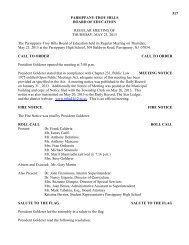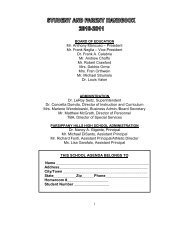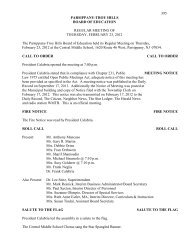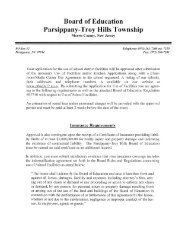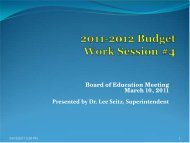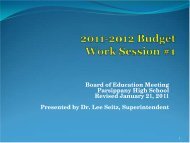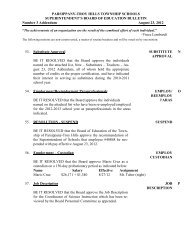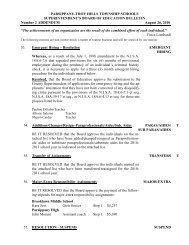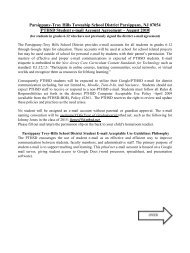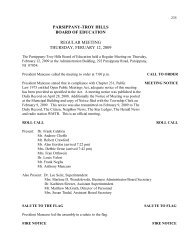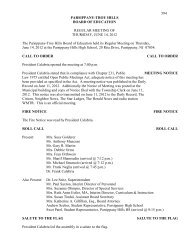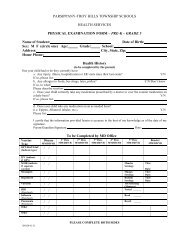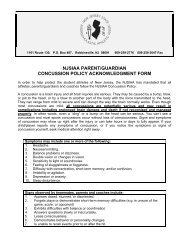Health Curriculum Grade 3 - the Parsippany-Troy Hills School District
Health Curriculum Grade 3 - the Parsippany-Troy Hills School District
Health Curriculum Grade 3 - the Parsippany-Troy Hills School District
You also want an ePaper? Increase the reach of your titles
YUMPU automatically turns print PDFs into web optimized ePapers that Google loves.
<strong>Health</strong> <strong>Grade</strong> 3 8ASSESSMENT PROCEDURESStudents are assessed on <strong>the</strong> following:Tests and Quizzes 10%Journal Responses 20%Prompted journal entriesOpen-ended responsesReflectionObservational Checklists 10%In-Class Assignments 30%ProjectsGroup workResearchWritten workOut of Class Assignments 10%ProjectsWritten workClass Participation 20%
<strong>Health</strong> <strong>Grade</strong> 3 9Proficiencies (Objectives)Students will be able to:1. describe <strong>the</strong> physical, socialand emotional/intellectualaspects of wellness and <strong>the</strong>factors that contribute togrowth and wellness.NJCCCStandardsNJCCC forTechnologicalLiteracySuggested ActivitiesStudents will:PERSONAL HEALTH2.1.A.1 • write a paragraph describing2.1.B.3ways to take responsibility forpersonal health.• answer <strong>the</strong> question, “How can<strong>the</strong>se actions help you improveyour physical, mental and emotionalhealth.• share writing with a classmate.Evaluations andAssessmentsTests and quizzes to be givenwhen appropriateTeacher assesses for content.Peer assessment based onestablished criteriaTeacherNotesDescribe one wayto share emotionsin a healthfulway.Write a skit ofhealthful ways toexpress emotion.Create a poster ofhealthful and riskbehaviors.List and describeways to show andreceive respectfrom o<strong>the</strong>rs.2. describe and demonstratepersonal hygiene practicesthat support wellness.2.1.A.22.1.A.3• place objects relating to wellnessinto a “wellness” box anddescribe how <strong>the</strong>y contribute togrowth and wellness.Teacher observationExamples forwellness box:towel, soap,comb, toothbrush• brainstorm a definition of wellness.• create a written plan focusing onan important health skill.Teacher and peer assessmentof health plan
<strong>Health</strong> <strong>Grade</strong> 3 10Proficiencies (Objectives)Students will be able to:3. describe <strong>the</strong> structure andfunction of various bodysystems.NJCCCStandardsNJCCC forTechnological LiteracySuggested ActivitiesStudents will:GROWTH AND DEVELOPMENT2.1.B.1 • use a jigsaw strategy to become anexpert on one piece of <strong>the</strong> bodysystem puzzle and report <strong>the</strong>irgroup findings to <strong>the</strong> class.Evaluations andAssessmentsTests and quizzes to be givenwhen appropriateTeacher evaluates according toestablished criteria.TeacherNotesCreate graphicorganizer of bodysystems4. describe each human lifestage and <strong>the</strong> physicalchanges that occur at eachstage.2.1.B.2 • create a flow chart tracking aperson from infancy to <strong>the</strong>ircurrent age. Students will discusshow <strong>the</strong> person changed as he/shegrew older.Teacher evaluates for understanding.Students comparein writing <strong>the</strong>way <strong>the</strong>y lookedand acted in <strong>the</strong>second or firstgrade to now.• make a list of student responses.5. differentiate between healthfuland unhealthful eatingpatterns and discuss how <strong>the</strong>ycontribute to wellness.2.1.C.12.1.C.4NUTRITION• create a healthy food notebookillustrating healthy food choicesand food labels. Students will explainwhy <strong>the</strong> foods were selectedand list <strong>the</strong> ingredients on <strong>the</strong> foodlabel.Assessed according to classdeterminedcriteria for healthyfoods.List positiveeffects of eatinghealthy, e.g.,energy, weight,disease.• brainstorm and list how healthfuleating patterns contribute to wellness.Teacher assesses for accuracy
<strong>Health</strong> <strong>Grade</strong> 3 12Proficiencies (Objectives)NJCCCStandardsNJCCC forTechnological LiteracyStudents will be able to:DISEASE AND HEALTH CONDITIONS (continued)8. explain that some diseases 2.1.D.3 8.1.A.5and health conditions arepreventable and some are not.Suggested ActivitiesStudents will:• create a disease chart illustratingdiseases that are communicable,and non-communicable, listing<strong>the</strong>ir symptoms, prevention andidentify germ(s) that causes <strong>the</strong>disease.• generate a chart using <strong>the</strong>computer.Evaluations andAssessmentsTests and quizzes to be givenwhen appropriateTeacher checklistTeacherNotesCreate astory/cartoonabout how <strong>the</strong>body preventsdisease, e.g., skin,white blood cells.Students canidentify healthfulhabits to reduce<strong>the</strong> risk ofchronic diseases.See <strong>District</strong>TechnologyScope andSequence9. investigate how to useuniversal precautions to helpprevent disease and healthconditions.2.1.D.5 • working in small groups, create anillness prevention booklet usingteacher-created criteria.Teacher compares to establishedcriteriaCreate a skitabout how toprotect environmentand healthas a community.10. describe <strong>the</strong> characteristics ofsafe and unsafe situations anddevelop strategies to reduce<strong>the</strong> risk of injuries at home,school and community.SAFETY2.1.E.1 • develop a safety rules chart forspecific situations (“What WillHappen”):1. Safety on <strong>the</strong> go (car)2. Indoor safety3. <strong>School</strong> safety4. Situational safetyTeacher checklistCreate a skit orposter of safe orunsafe practicesand describe whatis being shown.
<strong>Health</strong> <strong>Grade</strong> 3 13Proficiencies (Objectives)Students will be able to:SAFETY (continued)11. describe and demonstratesimple first aid procedures.NJCCCStandardsNJCCC forTechnological LiteracySuggested ActivitiesStudents will:2.1.E.2 • create a first aid kit.Evaluations andAssessmentsTests and quizzes to be givenwhen appropriateTeacher compares to establishedcriteriaTeacherNotes• write <strong>the</strong> purpose of each item in<strong>the</strong> kit and where <strong>the</strong> best place isto keep it.12. explain that abuse can takeseveral forms and identifyways to get help should abusebe suspected.2.1.E.32.1.F.48.1.A.8• use a graphic organizer to illustrate<strong>the</strong> various forms of abuse (verbal,emotional, sexual and physical).Students will include in <strong>the</strong>organizer ways to get help shouldabuse be suspected. (Graphicorganizer created using <strong>the</strong> computer.)Teacher checks for accuracy.See <strong>District</strong>TechnologyScope andSequence• write a letter to a friend illustratingone form of abuse and where toget help. Students will exchange<strong>the</strong>ir letters with ano<strong>the</strong>r classmatefor critical feedback.Peer assessment
<strong>Health</strong> <strong>Grade</strong> 3 14Proficiencies (Objectives)Students will be able to:13. describe basic human needsand how individuals andfamilies attempt to meet thoseneeds.NJCCCStandardsNJCCC forTechnological LiteracySuggested ActivitiesStudents will:SOCIAL AND EMOTIONAL HEALTH2.1.F.1 8.1.A.5 • create a needs chart indicating whofulfills those needs. (Chart createdusing <strong>the</strong> computer.)Evaluations andAssessmentsTests and quizzes to be givenwhen appropriateTeacher checks against identifiedcriteria.TeacherNotesSee <strong>District</strong>TechnologyScope andSequence14. distinguish among conflict,violence, vandalism, harassmentand bullying, anddiscuss factors that contributeto each.2.1.F.32.1.F.4• brainstorm <strong>the</strong> meaning of conflict,violence, vandalism, harassmentand bullying.Teacher observation of interactionIllustrate stepsinvolved in resolvingconflict.Use scenarios todemonstrateappropriate waysof dealing with aviolent situationor harassment.
<strong>Health</strong> <strong>Grade</strong> 3 15Proficiencies (Objectives)NJCCCStandardsNJCCC forTechnological LiteracySuggested ActivitiesStudents will be able to:Students will:SOCIAL AND EMOTIONAL HEALTH (continued)15. analyze <strong>the</strong> causes of stress 2.1.F.5 • be given an example of a stressfuland demonstrate ways to dealsituation, for instance: Your bookwith stressful situations.report is due tomorrow and youhaven’t finished reading <strong>the</strong> book.Students will write out ways toreduce stress including:1. Identify <strong>the</strong> signs of stress2. Identify <strong>the</strong> cause of stress3. Do something about <strong>the</strong> causeof <strong>the</strong> stress.4. Take action to reduce <strong>the</strong>harmful effects of stress.Evaluations andAssessmentsTests and quizzes to be givenwhen appropriateTeacher assesses for accuracyand completenessTeacherNotesStudents traceoutline of humanform; highlightareas affected bystress.Create a “Stressand You” pamphletfor kidshighlighting signsof stress andhealthful actionsone can take toreduce stress.16. describe and demonstrate avariety of ways to access andconvey information regardinghealth resources.COMMUNICATION2.2.A.1 • brainstorm sources of informationabout health and <strong>the</strong>n focus on <strong>the</strong>kind of information and how toaccess <strong>the</strong> information. Studentswill in small groups plan anddesign a health newspaper illustrating<strong>the</strong> ways <strong>the</strong>y discovered toaccess and convey health resources.Assessed against a teachercreatedchecklistList 3 sources ofhealth informationand identifywhy <strong>the</strong>y arereliable sources.
<strong>Health</strong> <strong>Grade</strong> 3 16Proficiencies (Objectives)NJCCCStandardsStudents will be able to:COMMUNICATION (continued)17. describe and demonstrate <strong>the</strong> 2.2.A.3effective use of communicationskills, including refusal,2.2.A.4negotiation and assertiveness.NJCCC forTechnological LiteracySuggested ActivitiesStudents will:• work in three groups. One groupwill give information aboutrefusal, ano<strong>the</strong>r negotiation, and<strong>the</strong> third assertiveness. The activitywill be conducted using afishbowl setting. One group willtalk about <strong>the</strong> topic while <strong>the</strong> o<strong>the</strong>rgroup will listen. The teacher willprovide essential questions for <strong>the</strong>students to respond to following<strong>the</strong> activity.Evaluations andAssessmentsTests and quizzes to be givenwhen appropriateStudents will complete ateacher-generated form.Peer assessmentTeacherNotesExplain howgiving someoneyour full attentionwhen <strong>the</strong>y arespeaking showsrespect.18. explain how to identify healthproblems or issues for possibleresearch.2.2.A.5 • investigate health magazines aswell as magazine publications(Newsweek). Students will selectone current health topic, e.g.,obesity, and explain why <strong>the</strong>y feel<strong>the</strong> issue is a problem and requirespossible research. Students willrecord <strong>the</strong>ir findings in <strong>the</strong>ir<strong>Health</strong> Journal.Journal assessment
<strong>Health</strong> <strong>Grade</strong> 3 17Proficiencies (Objectives)Students will be able to:19. outline <strong>the</strong> steps to making aneffective health decision.NJCCCStandardsNJCCC forTechnological LiteracySuggested ActivitiesStudents will:DECISION-MAKING2.2.B.1 • complete workbook page 11(<strong>Health</strong> and Wellness), “Whatwould you do?” Students will use<strong>the</strong> guidelines illustrated to makeresponsible decisions about eachsituation.Evaluations andAssessmentsTests and quizzes to be givenwhen appropriateTeacher assesses for accuracy.TeacherNotes20. evaluate how parents, peers,and <strong>the</strong> media influencehealth decisions and behaviors.2.2.B.22.2.B.3• select a parent, nurse, guidancecounselor or teacher to interviewand ask <strong>the</strong> following questions:1. When you were a teenager, doyou remember feeling peerpressure?2. Do media ads influence <strong>the</strong>food products you purchase?3. Why do you think you madehealthy choices?4. In what areas and at what agedid you worry most about whatfriends thought?5. How did you resist peerpressure?Teacher assesses for completeness.
<strong>Health</strong> <strong>Grade</strong> 3 18Proficiencies (Objectives)Students will be able to:21. develop a personal health goaland track <strong>the</strong> progress.NJCCCStandardsNJCCC forTechnological LiteracySuggested ActivitiesStudents will:PLANNING AND GOAL SETTING2.2.C.1 • be provided with a list of possiblehealth goals. Each student willpick one health goal and completea teacher-designed letter to his/herparent or guardian describing <strong>the</strong>goal and asking for help to achieveit. The student will include a chartwhich <strong>the</strong> parent/guardian willsign each time <strong>the</strong> student meets<strong>the</strong> goal.Evaluations andAssessmentsTests and quizzes to be givenwhen appropriateTeacher checks for completeness.TeacherNotes22. describe traits and core ethicalvalues such as trustworthyness,responsibility, respect,caring, justice, fairness, andgood citizenship.CHARACTER AND DEVELOPMENT2.2.D.1 8.1.A.8 • create a graphic organizer indicatingethical values and listing traitsassociated with those values, e.g.,responsibility, respect, trustworthiness,caring, justice,fairness and good citizenship.(Graphic organizer created using <strong>the</strong>computer.)Teacher assesses against ateacher-created checklistSee <strong>District</strong>TechnologyScope andSequence
<strong>Health</strong> <strong>Grade</strong> 3 19Proficiencies (Objectives)Students will be able to:23. describe and demonstrate <strong>the</strong>characteristics of an effectiveleader.NJCCCStandardsNJCCC forTechnological LiteracySuggested ActivitiesStudents will:LEADERSHIP, ADVOCACY AND SERVICES2.2.E.1 • working in small groups, list fivequalities of an effective leader andidentify one leadership role. Eachgroup will represent its list to <strong>the</strong>class from which a master list willbe developed.Evaluations andAssessmentsTests and quizzes to be givenwhen appropriateStudents self-assess <strong>the</strong>irability to work in a group.TeacherNotes24. acknowledge <strong>the</strong> contributionsof group members andchoose appropriate ways tomotivate <strong>the</strong>m and celebrate<strong>the</strong>ir accomplishments.2.2.E.2 • write down on an index card <strong>the</strong>name of <strong>the</strong> person sitting to <strong>the</strong>irright and list at least two positivecharacteristics about that person.Students will include one way tocelebrate or compliment thatperson.Teacher assesses for accuracyduring activity
<strong>Health</strong> <strong>Grade</strong> 3 20Proficiencies (Objectives)NJCCCStandardsNJCCC forTechnological LiteracySuggested ActivitiesStudents will be able to:Students will:LEADERSHIP, ADVOCACY AND SERVICES (continued)25. demonstrate respect for <strong>the</strong> 2.2.E.3• answer an open-ended questionopinions and abilities of group 2.2.E.4that deals with an opinion, e.g.,members.“All children like to eat icecream.” The students will bedivided into two small groups, onethat defends <strong>the</strong> statement and onethat opposes <strong>the</strong> statement. Theywill present <strong>the</strong>ir viewpointsorally. The oral project will bevideotaped.Evaluations andAssessmentsTests and quizzes to be givenwhen appropriateVideotape assessmentTeacherNotesExplain why it isimportant to havea variety ofopinions in agroup.26. analyze laws and regulationscreated to enhance wellness.2.2.E.52.2.E.6• be divided into small groups to listreasons why alcohol, tobacco productsand prescription medicineshould not be sold to children.Each group will present its list anddiscuss.Oral presentation assessed forcompleteness.
<strong>Health</strong> <strong>Grade</strong> 3 21Proficiencies (Objectives)Students will be able to:27. describe health and fitnessservices provided in <strong>the</strong>school and community.NJCCCStandardsNJCCC forTechnological LiteracySuggested ActivitiesStudents will:HEALTH SERVICES AND CAREERS2.2.F.1 • participate in a brainstormingactivity listing all <strong>the</strong> health andfitness service <strong>the</strong>y are aware of in<strong>the</strong> community.Evaluations andAssessmentsTests and quizzes to be givenwhen appropriateStudent list compared againstteacher-developed listTeacherNotesIdentify at leastthree sourceswhere you canfind informationon <strong>the</strong> servicesthat are availablewithin <strong>the</strong>community.28. demonstrate how to seek helpfor a variety of health andfitness concerns.2.2.F.22.2.F3• plan a health fair. Brainstormpeople <strong>the</strong>y would invite to speakfrom <strong>the</strong> community and present avariety of health and fitness topics.Students will follow <strong>the</strong> prescribedguidelines given by <strong>the</strong> teacher.Assessed by teacher for completeness.List five peoplewho can assistwith fitness andwellnessconcerns.
<strong>Health</strong> <strong>Grade</strong> 3 22Proficiencies (Objectives)Students will be able to:29. distinguish between prescriptionand over-<strong>the</strong>-countermedicines.NJCCCStandards2.3.A.12.3.A.3NJCCC forTechnological LiteracySuggested ActivitiesStudents will:MEDICINES• be given several empty/clearsamples of prescription and nonprescriptionmedicines. They willseparate <strong>the</strong> medicines intogroups: “prescription” and “nonprescription,”and list what <strong>the</strong>yshould look for on <strong>the</strong> packagingthat would give <strong>the</strong>m clues tomake <strong>the</strong>ir decision. Students willinclude why it is important to takemedicine as directed.Evaluations andAssessmentsTests and quizzes to be givenwhen appropriateAssessed for accuracy againstteacher checklist.TeacherNotes30. identify commonly usedmedicines and discuss why<strong>the</strong>y are used.2.3.A.2 • be given a list of commonly usedmedicines. Using a teachercreatedworksheet, <strong>the</strong>y will match<strong>the</strong> medicine to its use.Teacher assesses for accuracy.
<strong>Health</strong> <strong>Grade</strong> 3 23Proficiencies (Objectives)NJCCCStandardsNJCCC forTechnological LiteracySuggested ActivitiesStudents will be able to:Students will:ALCOHOL, TOBACCO AND OTHER DRUGS31. identify several illegal drugs. 2.3.B.5 8.1.A.5 • create as a class an illegal drugchart listing <strong>the</strong> definition andeffects of each drug.Drug Definition EffectMarijuanaInhalantCocaineCrackEcstasy(Teacher-created chart, informationfilled in by students)Evaluations andAssessmentsTests and quizzes to be givenwhen appropriateProject assessed for accuracy.TeacherNotesSee <strong>District</strong>TechnologyScope andSequence32. identify short and long-termphysical effects of tobaccouse.2.3.B.22.3.B.3• observe a teacher-created smokingmachine. Students will record<strong>the</strong>ir observations in <strong>the</strong>ir <strong>Health</strong>Journal. They will identify <strong>the</strong>immediate short-term effects andpredict long-term effects.Journal entryStudents pretend<strong>the</strong>y have a friendwho recentlystarted smoking,write a letter toexplain why <strong>the</strong>friend shouldquit, and list <strong>the</strong>effects upon <strong>the</strong>smoker and nonsmoker.
<strong>Health</strong> <strong>Grade</strong> 3 24Proficiencies (Objectives)NJCCCStandardsNJCCC forTechnological LiteracySuggested ActivitiesStudents will be able to:Students will:ALCOHOL, TOBACCO AND OTHER DRUGS (continued)33. identify <strong>the</strong> physical and 2.3.B.4 • make a cause-and-effect table withbehavioral effects of alcohol<strong>the</strong> title, “Effects of Drinkinguse and abuse.Alcohol,” including <strong>the</strong> headings:“Physical <strong>Health</strong>,” “Thoughts,”“Feelings,” and “Action.” Theywill include <strong>the</strong> table in <strong>the</strong>ir<strong>Health</strong> Journal and fill it in as <strong>the</strong>class proceeds.Evaluations andAssessmentsTests and quizzes to be givenwhen appropriateJournal entryTeacherNotes34. identify where individualswith a substance abuse problemcan get help.DEPENDENCY, ADDICTION AND TREATMENT2.3.C.2 • use a Chalk-Talk activity to brainstormsupport services for indivi-teacher-generated list.Student list compared toduals with a substance abuse problem.35. differentiate among drug use,abuse and misuse.2.3.C.3 • working in three groups, researchdrug use, drug abuse and drugmisuse. Each group will make amulti-media presentation to <strong>the</strong>class using illustrations.Project assessed compared toteacher-developed criteria.
<strong>Health</strong> <strong>Grade</strong> 3 25Proficiencies (Objectives)Students will be able to:36. describe different kinds offamilies and how <strong>the</strong>y canshare love, values andtraditions, provide emotionalsupport and set boundariesand limits.NJCCCStandardsNJCCC forTechnological LiteracySuggested ActivitiesStudents will:RELATIONSHIPS2.4.A.1 • working in small groups, respondingto <strong>the</strong> following teachergeneratedstatements:1. All families have <strong>the</strong> samenumber of people.2. Families can celebrate differentholidays.3. All families live in a house.4. Mo<strong>the</strong>rs and fa<strong>the</strong>rs livetoge<strong>the</strong>r.Students will use a whip-aroundstrategy to respond to <strong>the</strong>statements and clarify misconceptions.Evaluations andAssessmentsTests and quizzes to be givenwhen appropriateStudent’s oral response assessedfor understanding.TeacherNotes37. compare <strong>the</strong> roles, rights andresponsibilities of variousfamily members.2.4.A.2 • respond to <strong>the</strong> words, role,responsibility, privilege and rightsin <strong>the</strong>ir <strong>Health</strong> JournalJournal entry• Students will develop a list of jobs<strong>the</strong>y are required to do at homeand report on <strong>the</strong>m orally. Eachstudent keeps a diary for twoweeks and records every time <strong>the</strong>yperform family tasks.Diary entry
<strong>Health</strong> <strong>Grade</strong> 3 26Proficiencies (Objectives)Students will be able to:RELATIONSHIPS (continued)38. explain ways that familiescan adjust to changes in <strong>the</strong>nature or structure of <strong>the</strong>family.NJCCCStandards2.4.A.3NJCCC forTechnological Literacy8.1.A.5Suggested ActivitiesStudents will:• respond using a whip-around, passoption activity to brainstorm waysfamily change. Responses will berecorded on <strong>the</strong> board. The classwill be divided into small groupsand each group will be assignedtwo changes. Students willdiscuss <strong>the</strong> change and develop aChange Chart.FamilyChangeWhat HappensHow I FeelMove Get my own room GreatMove Leave my friends Sad(Teacher-created chart, informationfilled in by students)Evaluations andAssessmentsTests and quizzes to be givenwhen appropriateChange Chart assessed forcompleteness and understanding.TeacherNotesSee <strong>District</strong>TechnologyScope andSequence39. explain behaviors andcharacteristics that suppor<strong>the</strong>althy relationships withfriends and family.2.4.A.58.1.A• brainstorm what constitutes healthyrelationships with friends andfamily. Students will record <strong>the</strong>irresponses on a petal-shaped cardtitled, “Kines<strong>the</strong>tic Activity.”Students will place <strong>the</strong>irpetal/response on <strong>the</strong> flower ofhealthy relationships.Concluding <strong>the</strong> activity,students will self-assess <strong>the</strong>contribution with a thumbs-upor thumbs-down.Identify fourbehaviors thatshow respect to afriend and/orfamily member.See <strong>District</strong>TechnologyScope andSequence
<strong>Health</strong> <strong>Grade</strong> 3 27Proficiencies (Objectives)Students will be able to:40. describe <strong>the</strong> physical, socialand emotional changes thatoccur at puberty.NJCCCStandardsNJCCC forTechnological LiteracySuggested ActivitiesStudents will:SEXUALITY• draw a flow chart tracking <strong>the</strong>changes of a developing humanbeing. Students will draw aperson at each stage identifyinghow <strong>the</strong> person changed physically,mentally and emotionally.Evaluations andAssessmentsTests and quizzes to be givenwhen appropriateTeacher assesses flow chart forcompleteness.TeacherNotes41. evaluate how <strong>the</strong> health of<strong>the</strong> birth mo<strong>the</strong>r impacts <strong>the</strong>development of <strong>the</strong> fetus.PREGNANCY AND PARENTING• interview an expectant mo<strong>the</strong>r andask a series of questions pertainingto <strong>the</strong> health and well-being of <strong>the</strong>unborn child. (The questions willbe developed by <strong>the</strong> teacher.)Teacher assesses for understanding.
<strong>Health</strong> <strong>Grade</strong> 3 28BIBLIOGRAPHY/RESOURCESTEXT:Meeks, Linda and Philip Heit. <strong>Health</strong> and Wellness. New York, New York: MacMillan, 2005.WEBSITES:www.mmhhealth.comwww.dole.com
APPENDIX ASAMPLE AUTHENTIC ASSESSMENT
SAMPLE AUTHENTIC ASSESSMENTHEALTHFUL LUNCHSCENARIO:You are an athlete in training. You need a variety of foods to fuel your body. You will be eating lunch at a fast-food restaurant.TASK:Select a fast-food meal that would be appropriate for an athlete in training. You will need to explore several different menus, compare foodselections to <strong>the</strong>ir place on <strong>the</strong> Food Pyramid as well as <strong>the</strong>ir nutritional content to <strong>the</strong> daily requirements.Select and build your lunch menu. Include in your planning why you selected <strong>the</strong> menu items and how many different food groups are represented.You will identify <strong>the</strong> key six (6) nutrients in your meal. You must be able to defend your choices based on <strong>the</strong> information you have learned in class.
RUBRIC FOR SAMPLE AUTHENTIC ASSESSMENTHEALTHFUL LUNCH4Student selects a variety ofappropriate foods from each foodgroup.3 2 1Student selects only a few foodsfrom each food group.Student selects only a moderatevariety of appropriate foods fromeach food group.Student is unable to selectappropriate foods from <strong>the</strong> foodgroups.Student is able to explain whyhe/she chose <strong>the</strong> foods from <strong>the</strong>fast-food menu in detail, based on<strong>the</strong> nutritional guidelines.Student offers an explanation ofhis/her choices from <strong>the</strong> fast-foodmenu that is thorough, but lacksdetails based on <strong>the</strong> nutritionalguidelines.Student is able to explain only afew reasons he/she chose <strong>the</strong> foodsfrom <strong>the</strong> fast-food menu based on<strong>the</strong> nutritional guidelines.Student is unable to explain withany detail why he/she chose <strong>the</strong>foods from <strong>the</strong> fast-food menu.The foods do not represent appropriatechoices from <strong>the</strong> FoodPyramid and lack nutritional content.Student’s menu identifies at least 6key nutrients.Student’s menu identifies at least 5key nutrients.Student’s menu identifies 4 keynutrients.Student’s menu does not identifyany key nutrients.
APPENDIX BNEW JERSEY CORE CURRICULUM CONTENT STANDARDSFOR HEALTH
COMPREHENSIVE HEALTH AND PHYSICAL EDUCATION STANDARDS AND PROGRESS INDICATORSSTANDARD 2.1(WELLNESS) ALL STUDENTS WILL LEARN AND APPLY HEALTH PROMOTION CONCEPTS AND SKILLSTO SUPPORT A HEALTHY, ACTIVE LIFESTYLE.Building upon knowledge and skills gained in <strong>the</strong> preceding grades, by <strong>the</strong> end of <strong>Grade</strong> 4 students:A. Personal <strong>Health</strong>1. Describe <strong>the</strong> physical, social and emotional dimensions of wellness.2. Describe and demonstrate personal hygiene practices that support wellness.3. Analyze <strong>the</strong> impact of health choices and behaviors on wellness.B. Growth and Development1. Describe <strong>the</strong> structure and function of human body systems.2. Describe each human life stage and <strong>the</strong> physical changes that occur at each stage.3. Discuss factors that contribute to healthy physical, social, emotional and intellectual growth and uniqueness.C. Nutrition1. Differentiate between healthy and unhealthy eating patterns.2. Classify foods by food group, food source, nutritional content and nutritional value.3. Interpret food product labels.4. Discuss how healthy eating provides energy, helps to maintain healthy weight, lowers risk of disease, and keeps body systems working.D. Diseases and <strong>Health</strong> Conditions1. Discuss and importance of <strong>the</strong> early detection of diseases and health conditions.2. Investigate ways to treat common childhood diseases and health conditions.3. Explain that some diseases and health conditions are preventable and some are not.4. Describe <strong>the</strong> signs and symptoms of diseases and health conditions common in children.5. Investigate how <strong>the</strong> use of universal precautions, sanitation and waste disposal, proper food handling and storage, and environmental controlshelp to prevent diseases and health conditions.6. Discuss myths and facts about mental illness.
NJCCC STANDARDS (2.1 continued)E. Safety1. Describe <strong>the</strong> characteristics of safe and unsafe situations and develop strategies to reduce <strong>the</strong> risk of injuries at home, school and community.2. Describe and demonstrate simple first aid procedures, including <strong>the</strong> assessment of choking and breathing, <strong>the</strong> control of bleeding, and <strong>the</strong>care of minor wounds and burns.3. Explain that abuse can take several forms, including verbal, emotional, sexual and physical, and identify ways to get help should abuse besuspected.4. Describe <strong>the</strong> characteristics of strangers, acquaintances and trusted adults and demonstrate safe and appropriate ways to deal with each.F. Social and Emotional <strong>Health</strong>1. Describe basic human needs and how individuals and families attempt to meet those needs.2. Discuss how culture, peers and <strong>the</strong> media impact <strong>the</strong> way individuals communicate and express emotions, and how emotions can affectcommunication, choices and behaviors.3. Distinguish among conflict, violence, vandalism, harassment and bullying, and discuss factors that contribute to each.4. Describe and demonstrate strategies to prevent, reduce or mediate conflict.5. Discuss <strong>the</strong> causes of stress and demonstrate ways to deal with stressful situations.6. Explain and demonstrate ways to cope with rejection, loss and separation.7. Explain how stereotypes influence personal growth and behavior.
STANDARD 2.2(INTEGRATED SKILLS) ALL STUDENTS WILL USE HEALTH-ENHANCING PERSONAL, INTERPERSONALAND LIFE SKILLS TO SUPPORT A HEALTHY, ACTIVE LIFESTYLE.Building upon knowledge and skills gained in <strong>the</strong> preceding grades by <strong>the</strong> end of <strong>Grade</strong> 4, students:A. Communication1. Explain how to determine <strong>the</strong> validity and reliability of a health resource.2. Present health information orally and in writing to peers.3. Describe and demonstrate <strong>the</strong> effective use of communication skills, including refusal, negotiation and assertiveness.4. Identify and employ ways to improve listening skills.5. Explain how to identify a health problem or issue for possible research.B. Decision-Making1. Outline <strong>the</strong> steps to making an effective decision.2. Discuss how parents, peers and <strong>the</strong> media influence health decisions and behaviors.3. Describe situations that might require a decision about health and safety.C. Planning and Goal Setting1. Develop a personal health goal and track progress.2. Describe ways to support <strong>the</strong> achievement of health goals.D. Character Development1. Describe character traits and core ethical values such as trustworthiness, responsibility, respect, caring, justice, fairness, civic virtue andcitizenship.2. Discuss how an individual’s character positively impacts individual and group goals and success.
NJCCC STANDARDS (2.2 continued)E. Leadership, Advocacy and Service1. Describe and demonstrate <strong>the</strong> characteristics of an effective leader.2. Acknowledge <strong>the</strong> contributions of group members and choose appropriate ways to motivate <strong>the</strong>m and celebrate <strong>the</strong>ir accomplishments.3. Demonstrate respect for <strong>the</strong> opinions and abilities of group members.4. Develop and articulate group goals.5. Develop a position on a wellness issue.\6. Discuss laws and regulations created to enhance wellness.7. Organize and participate in a school or community service activity and discuss how helping o<strong>the</strong>rs impacts personal and communitywellness.F. <strong>Health</strong> Services and Careers1. Describe health and fitness services provided in <strong>the</strong> school and community.2. Describe and demonstrate how to seek help for a variety of health and fitness concerns.3. Discuss wellness and fitness careers.
STANDARD 2.3(DRUGS AND MEDICINES) ALL STUDENTS WILL LEARN AND APPLY INFORMATION ABOUT ALCOHOL,TOBACCO AND OTHER DRUGS AND MEDICINES TO MAKE DECISIONS THAT SUPPORT A HEALTHY,ACTIVE LIFESTYLE.Building upon knowledge and skills gained in <strong>the</strong> preceding grades by <strong>the</strong> end of <strong>Grade</strong> 4, students:A. Medicines1. Distinguish between over-<strong>the</strong>-counter and prescription medicines.2. Identify commonly used medicines and discuss why <strong>the</strong>y are used.3. Discuss <strong>the</strong> importance of taking medicines as ordered, not sharing medicines with o<strong>the</strong>rs, and reporting any side effects to a trusted adult.B. Alcohol, Tobacco and O<strong>the</strong>r Drugs1. Explain why it is illegal to use or possess certain drugs/substances.2. Describe <strong>the</strong> short- and long-term physical effects of tobacco use.3. Discuss <strong>the</strong> impact of second-hand/passive smoke on <strong>the</strong> health of non-smokers.4. Identify <strong>the</strong> short- and long-term physical and behavioral effects of alcohol use and abuse.5. Identify <strong>the</strong> physical and behavioral effects of marijuana use.6. Explain that brain damage, lung damage and death can occur from inhaling certain substances such as solvents, propellants and medicinalgases.C. Dependency/Addiction and Treatment1. Discuss signs that a person might have a problem with <strong>the</strong> use of alcohol, tobacco and o<strong>the</strong>r drugs.2. Identify where individuals with a substance abuse problem can get help.3. Differentiate among drug use, abuse and misuse.4. Describe how advertising, peers and adults influence children and teenagers to try alcohol, tobacco and o<strong>the</strong>r drugs.
STANDARD 2.4(HUMAN RELATIONSHIPS AND SEXUALITY) ALL STUDENTS WILL LEARN THE PHYSICAL, EMOTIONALAND SOCIAL ASPECTS OF HUMAN RELATIONSHIPS AND SEXUALITY AND APPLY THESE CONCEPTS TOSUPPORT A HEALTHY, ACTIVE LIFESTYLE.Building upon knowledge and skills gained in <strong>the</strong> preceding grades by <strong>the</strong> end of <strong>Grade</strong> 4, students:A. Relationships1. Describe different kinds of families and discuss how families can share love, values and traditions, provide emotional support, and setboundaries and limits.2. Compare <strong>the</strong> roles, rights and responsibilities of various family members.3. Discuss ways that families adjust to changes in <strong>the</strong> nature or structure of <strong>the</strong> family.4. Discuss how culture and tradition influence personal and family development.5. Discuss factors that support healthy relationships with friends and family.6. Describe <strong>the</strong> characteristics of a friend.7. Describe appropriate ways to show affection and caring.B. Sexuality1. Describe <strong>the</strong> physical, social and emotional changes occurring at puberty.2. Discuss why puberty begins and ends at different ages for different people.C. Pregnancy and Parenting1. Explain that after fertilization, cells divide to create a fetus/embryo that grows and develops inside <strong>the</strong> uterus during pregnancy.2. Discuss how <strong>the</strong> health of <strong>the</strong> birth mo<strong>the</strong>r impacts <strong>the</strong> development of <strong>the</strong> fetus.
APPENDIX CCORE CURRICULUM CONTENT STANDARDSFORTECHNOLOGICAL LITERACY
NEW JERSEY CORE CURRICULUM CONTENT STANDARDSFOR TECHNOLOGICAL LITERACYSTANDARD 8.1 (COMPUTER AND INFORMATION LITERACY) ALL STUDENTS WILL USE COMPUTER APPLICATIONS TOGATHER AND ORGANIZE INFORMATION AND TO SOLVE PROBLEMS.Building upon knowledge and skills gained in preceding grades, by <strong>the</strong> end of <strong>Grade</strong> 4, students will:A. Basic Computer Skills and Tools1. Use basic technology vocabulary.2. Use basic features of an operating system (e.g., accessing programs, identifying and selecting a printer, finding help).3. Input and access text and data, using appropriate keyboarding techniques or o<strong>the</strong>r input devices.4. Produce a simple finished document using word processing software.5. Produce and interpret a simple graph or chart by entering and editing data on a prepared spreadsheet template.6. Create and present a multimedia presentation using appropriate software.7. Create and maintain files and folders.8. Use a graphic organizer.9. Use basic computer icons.B. Application of Productivity ToolsSocial Aspects:1. Discuss <strong>the</strong> common uses of computer applications and identify <strong>the</strong>ir advantages and disadvantages.2. Recognize and practice responsible social and ethical behaviors when using technology and understand <strong>the</strong> consequences of inappropriateuse including:• Internet access• Copyrighted materials• On-line library resources• Personal security and safety issues3. Practice appropriate Internet etiquette.4. Recognize <strong>the</strong> ethical and legal implications of plagiarism of copyrighted materials.
NJCCC STANDARDS FOR TECHNOLOGICAL LITERACY (8.1B continued)Information Access and Research:5. Recognize <strong>the</strong> need for accessing and using information.6. Identify and use web browsers, search engines and directories to obtain information to solve real-world problems.7. Locate specific information by searching a database.8. Recognize accuracy and/or bias of information.Problem-Solving and Decision-Making:9. Solve problems individually and/or collaboratively using computer applications.10. Identify basic hardware problems and solve simple problems.STANDARD 8.2 (TECHNOLOGY EDUCATION) ALL STUDENTS WILL DEVELOP AN UNDERSTANDING OF THE NATUREAND IMPACT OF TECHNOLOGY, ENGINEERING, TECHNOLOGICAL DESIGN AND THE DESIGNEDWORLD AS THEY RELATE TO THE INDIVIDUAL, SOCIETY AND THE ENVIRONMENT.Building upon knowledge and skills gained in preceding grades, by <strong>the</strong> end of <strong>Grade</strong> 4, students will:A. Nature and Impact of TechnologyRefer to Science Standards 5.2 and 5.4B. Design process and Impact AssessmentRefer to Science Standards 5.2 and 5.4C. Systems in <strong>the</strong> Designed WorldRefer to Science Standards 5.2 and 5.4



